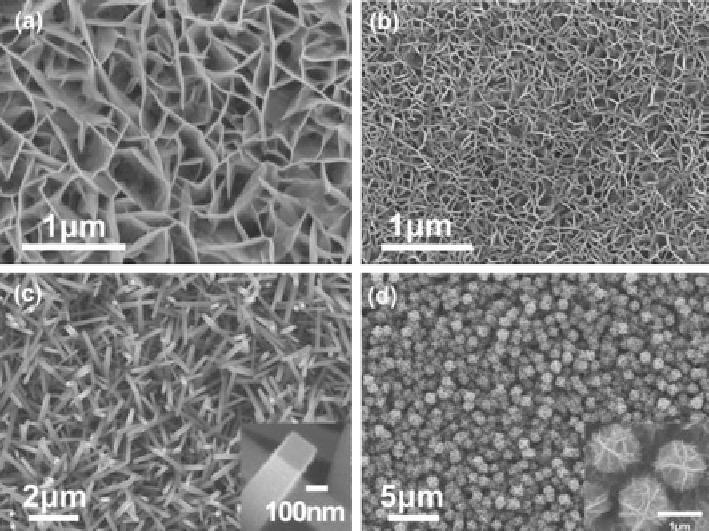Biomedical Engineering Reference
In-Depth Information
Fig. 9.6
(
a
-
d
) SEM images of MnO
2
MLS, TNS, and BCS films. (
a
-
b
) Large and small mesh
size MLS. (
c
)TNSfilm.(
d
) BCS film. Reprinted with permission from ref. [
34
]. Copyright (2011)
American Chemical Society
thermodynamic equilibrium conditions. Subsequently, the nanopin was treated with
lauric acid (with
75.1) to acquire a superhydrophobic surface, of which the
measured water CA is 178
ı
.
Wu et al. [
119
] also used CBD to prepare uniform and dense superhydrophobic
surfaces of zinc oxide (ZnO) nanorods with diameters ranging from 400 to 600 nm
glass slides as substrate, using a solution mixture of Zn(NO
3
)
2
,NH
4
Cl, urea, and
ammonia. Surface modification with SAMs of alkanoic acids of different chain
length generate substrates with high advancing contact angle (
>
150
ı
), and different
receding angles determined by the chain length of the alkanoic acids.
Zhao et al. [
50
] have prepared the MnO
2
nanotube array (MTA) membrane
by the simple and low-cost hydrothermal treatment of a solution of KMnO4 and
HCl. The open end and the square cross-section of the nanotubes can be clearly
observed. The average length of MnO2 nanotube is 2
m and outer diameter
and wall thickness are 103 nm and 23 nm, respectively. The density of the MAT
membrane is about 2.38 tubes
m
2
. The as-prepared MTA membrane was nearly
superhydrophilic with a CA of 6
ı
. It was further treated by stearic acid sodium to
achieve superhydrophobicity with a CA of 160.9
ı
and a small slide angle (
<
5
ı
).
To acquire diverse adhesive property on superhydrophobic surfaces, Zhao et al.
[
34
] later prepared different patterns of MnO
2
films: a MLS, a BCS, and a TNS
(Fig.
9.6
) were synthesized on the basis of the hydrothermal method. In a typical
D

